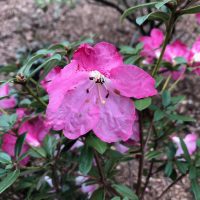Dispatch from home: Early, small and pink

In the spring of 1997 I came across an adorable little pink rhododendron called ‘Pink Snowflakes’. It was absolutely covered with small white flowers with a bright pink ruffled edge and a tiny smattering of pink dots in the throat. I brought it home and gave it a place of pride next to my driveway. Soon after a foraging deer rudely stepped on it, breaking off two thirds of the plant.
Read moreSelected Cuttings from the Home of Roy Farrow, WA Park Arboretum Grounds Supervisor

1) Acer palmatum ‘Katsura’ Japanese Maple
Japanese maples have been cultivated in Japan for over 300 years. While they are most known for their stunning fall colors, I personally enjoy them as much in the spring for their new leaf color.
‘Katsura’ is a cultivar which appears to have bright orange new leaves, but on closer inspection, the leaves are bright yellow with a red margin.
Preserving Partnerships and Unique Habitats

The Rare Plant Care and Conservation Program’s (Rare Care) partnership with the Washington Natural Heritage Program (WNHP) is invaluable and the relationships we build with their staff create a strong foundation for our program. As such, we like to spotlight the people we work with at WNHP like Joe Rocchio, the new Program Manager. Joe’s tenure for Heritage Programs began in 1999 when he worked for the Colorado Natural Heritage Program as a wetland ecologist.
Read moreApril 2020 Plant Profile: Magnolia ernestii
-200x200.jpg)
Magnolias, magnolias, magnolias! Where to begin?! These harbingers of spring have started to bloom! The Washington Park Arboretum has 250 magnolia tree specimens, with some impressively mature trees dating back to 1940. Lucky for us, the breadth and variety of the University of Washington Botanic Gardens’ collection means we should have a steady supply of magnolia blooms through the summer.
Of the 250 magnolia specimens, there are 38 species, subspecies and varieties (i.e.
Seeding for the Future

Last fall, the Rare Plant Care and Conservation Program (Rare Care) initiated a new study to investigate whether direct seeding is a viable alternative for establishing new populations of White Bluffs bladder-pod (Physaria douglasii ssp. tuplashensis). The only known population of this plant occurs at the Hanford Reach National Monument. It grows on the white bluffs along the east side of the Columbia River on a white cemented alkaline substrate rich in calcium.
Read moreSpring Transition at the Washington Park Arboretum

1) Cornus mas Cornelian Cherry
This yellow flowering tree that blooms in late winter to early spring, is native to southern Europe and southwestern Asia.
The common name refers to the fruit that matures in late summer. The fruit has many cultural uses including jams, medicine, beverages, tools, and spears.
There is a grove of this Cornus at the Center for Urban Horticulture along NE 41st Street.
Arriba for Azaras!

Azara is a genus of plants native to the temperate and subtropical regions of South America. The Chilean name for these plants is Corcolén. The genus contains only ten species, four of which you can find growing here at the Washington Park Arboretum! All species of Azara are evergreen shrubs to small trees. Although some species of Azara are considered to be borderline hardy in our Pacific Northwest climate, we have had success growing them at the Arboretum.
Read more

